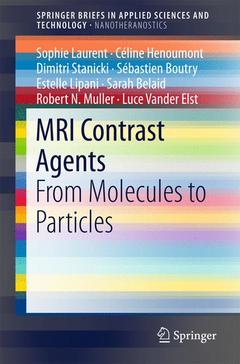MRI Contrast Agents, 1st ed. 2017 From Molecules to Particles Nanotheranostics Series
Auteurs : Laurent Sophie, Henoumont Céline, Stanicki Dimitri, Boutry Sébastien, Lipani Estelle, Belaid Sarah, Muller Robert N., Vander Elst Luce

This book describes the multiple aspects of (i) preparation of the magnetic core, (ii) the stabilization with different coatings, (iii) the physico-chemical characterization and (iv) the vectorization to obtain specific nanosystems. Several bio-applications are also presented in this book. In the early days of Magnetic Resonance Imaging (MRI), paramagnetic ions were proposed as contrast agents to enhance the diagnostic quality of MR images. Since then, academic and industrial efforts have been devoted to the development of new and more efficient molecular, supramolecular and nanoparticular systems. Old concepts and theories, like paramagnetic relaxation, were revisited and exploited, leading to new scientific tracks. With their high relaxivity payload, the superparamagnetic nanoparticles are very appealing in the context of molecular imaging but challenges are still numerous: absence of toxicity, specificity, ability to cross the biological barriers, etc.
Dr. Dimitri Stanicki did his graduate work at the University of Mons (Ph.D. degree in 2010), where he achieved the synthesis of organic compounds for the treatment of parasitic diseases. In 2011, he joined R. Muller’s research group (MRI) where he started to develop new nanosystems for molecular imaging applications. He is the co-author of approximatively 10 publications, including a patentand a chapter book in the field of superparamagnetic contrast agents.
Dr. Robert N. Muller, PhD in chemistry 1974 from the University of Mons-Hainaut where he was successively appointed Assistant, Lecturer and full Professor. Post-doctoral studies in Magnetic Resonance Imaging in Paul C. Lauterbur’s (2003 Nobel Prize in Medicine or Physiology) research group (MRI) at the State University of New York at Stony Brook in 1981-82 and sabbatical leave at the Center for Magnetic Resonance (CERM), Florence, Italy, in 2002-2003. He produced around 280 publications and 6 books. Currently Scientific Director of the Center for Microscopy and Molecular Imaging, Gosselies, Belgium.
Date de parution : 11-2016
Ouvrage de 125 p.
15.5x23.5 cm



